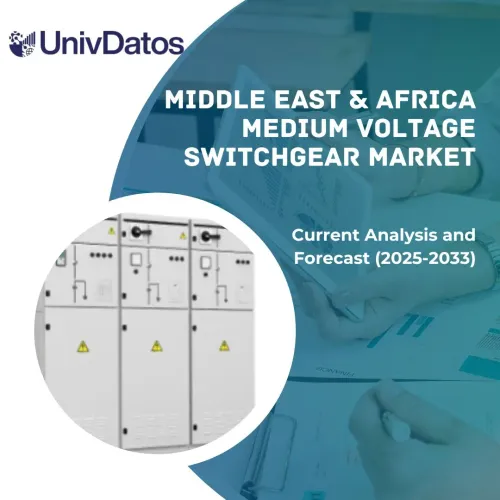- Strona główna
- O nas
- Branża
- Usługi
- Czytanie
- Kontakt
Rynek oleju próżniowego: analiza obecnej sytuacji i prognoza (2024-2032)
Nacisk na produkt (lekki olej próżniowy (LVGO) i ciężki olej próżniowy (HVGO)); Zawartość siarki (niskosiarkowy olej próżniowy i wysokosiarkowy olej próżniowy); Zastosowanie (produkcja benzyny i produkcja oleju napędowego); oraz Region/Kraj
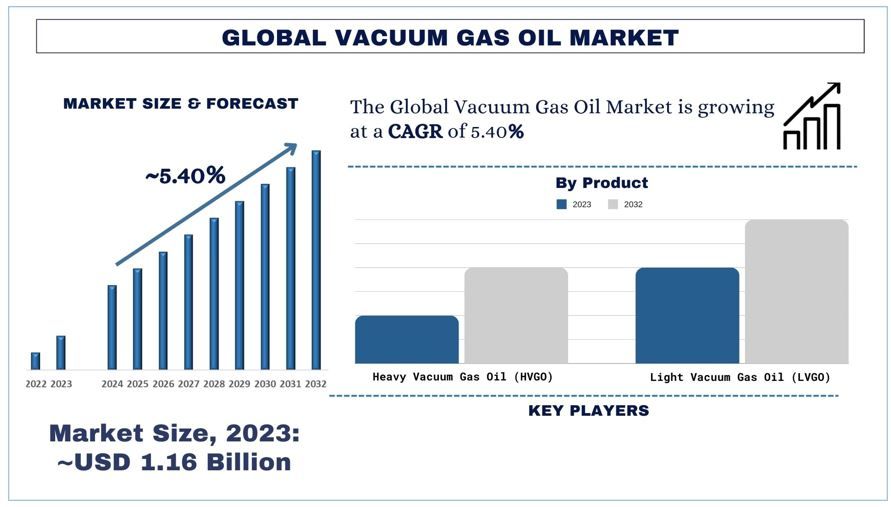 Wielkość i prognozy rynku oleju próżniowego (Vacuum Gas Oil Market)
Wielkość i prognozy rynku oleju próżniowego (Vacuum Gas Oil Market)
Wartość rynku oleju próżniowego (Vacuum Gas Oil) została oszacowana na około 1,16 miliarda USD w 2023 roku i oczekuje się, że będzie rósł w solidnym tempie CAGR wynoszącym około 5,40% w okresie prognozy (2024-2032) ze względu na rosnący globalny popyt na ropę i gaz.
Analiza rynku oleju próżniowego (Vacuum Gas Oil Market)
Olej próżniowy (VGO) to kategoria surowców wykorzystywana w wielu sektorach, głównie w sektorze rafineryjnym, który wytwarza wiele produktów naftowych. Drugi typ pochodzi z procesu destylacji próżniowej; proces ten następuje po początkowym procesie kolumn destylacji atmosferycznej i częściowej rafinacji ropy naftowej. VGO to ogólna mieszanka węglowodorów w średnim zakresie temperatury wrzenia, która może obejmować lekkie produkty, takie jak olej napędowy, oraz składniki o wyższej temperaturze wrzenia, które mogą być rafinowane do cięższych produktów, takich jak benzyna.
Globalny rynek oleju próżniowego (VGO) jest napędzany przez kilka czynników, wśród których na pierwszy plan wysuwa się rosnący popyt na paliwa transportowe, rozwijający się sektor petrochemiczny oraz udoskonalenia technologiczne w sektorze rafineryjnym. Wynika to z faktu, że wraz z rozwojem gospodarek i ich industrializacją wzrasta popyt na olej napędowy, paliwo lotnicze i benzynę, które można uzyskać z VGO. Ponadto w przemyśle petrochemicznym VGO jest wykorzystywany jako surowiec do produkcji chemikaliów stosowanych w produkcji tworzyw sztucznych, co zwiększa jego popyt. Czynniki technologiczne, które wpływają na procesy rafinacji i proces konwersji VGO w produkty o wysokiej wartości, również sprzyjają ekspansji rynku. Na przykład w 2021 roku ExxonMobil planował zainwestować ponad 1 miliard USD w przekształcenie istniejącej instalacji opóźnionego koksowania w jednostkę hydrokrakingu. Ta konwersja umożliwiłaby rafinerii przetwarzanie produktów o niższej wartości, takich jak VGO, na olej napędowy i paliwa okrętowe o wyższej wartości. Inwestycja była częścią strategii ExxonMobil mającej na celu optymalizację portfolio rafineryjnego i zwiększenie produkcji czystszych, bardziej wartościowych produktów w odpowiedzi na zmieniający się popyt rynkowy i wymagania regulacyjne.
Trendy na rynku oleju próżniowego (Vacuum Gas Oil Market)
W tej sekcji omówiono kluczowe trendy rynkowe wpływające na segmenty rynku oleju próżniowego, zidentyfikowane przez naszych ekspertów ds. badań.
Produkt przekształcający branżę
Oczekuje się, że lekki olej próżniowy (light vacuum gas oil) będzie rósł w znaczącym tempie CAGR w okresie prognozy (2024-2032) ze względu na rosnący popyt na benzynę i olej napędowy, dynamiczny rozwój globalnego przemysłu petrochemicznego oraz technologie refinansowania. Jest to wysoce preferowany surowiec do produkcji gazu i oleju napędowego, aby zaspokoić stale rosnące wymagania transportowe na całym świecie. Ponadto LVGO jest wykorzystywany w przemyśle petrochemicznym jako element budulcowy do produkcji chemikaliów i tworzyw sztucznych, co zwiększa jego zużycie. Wahania cen ropy naftowej oraz rosnące technologie i techniki w branży rafineryjnej w celu poprawy wartości produktu z LVGO przyczyniły się do wzrostu rynku. Ponadto inwestycje firm w budowę rynku, szczególnie w regionie Azji i Pacyfiku, również napędzają wzrost rynku.
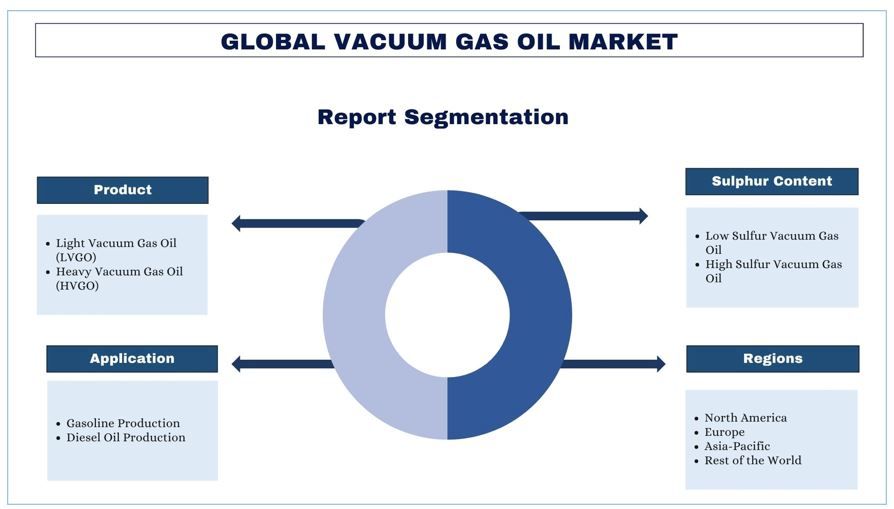
Oczekuje się, że Ameryka Północna będzie rosła w znaczącym tempie CAGR w okresie prognozy
Ameryka Północna posiada największy udział w rynku. Wzrost oleju próżniowego w Ameryce Północnej jest napędzany przez kilka kluczowych czynników. Rosnące wykorzystanie oleju próżniowego (VGO) w Ameryce Północnej jest napędzane przez rosnący popyt na rafinowane produkty naftowe, takie jak benzyna, olej napędowy i paliwo lotnicze. Rafinerie w regionie inwestują w zaawansowane technologie przetwarzania, aby efektywnie przekształcać VGO w produkty o wyższej wartości. Trend ten jest napędzany presją regulacyjną na produkcję czystszych paliw oraz potrzebą optymalizacji operacji rafineryjnych w celu zaspokojenia popytu rynkowego.
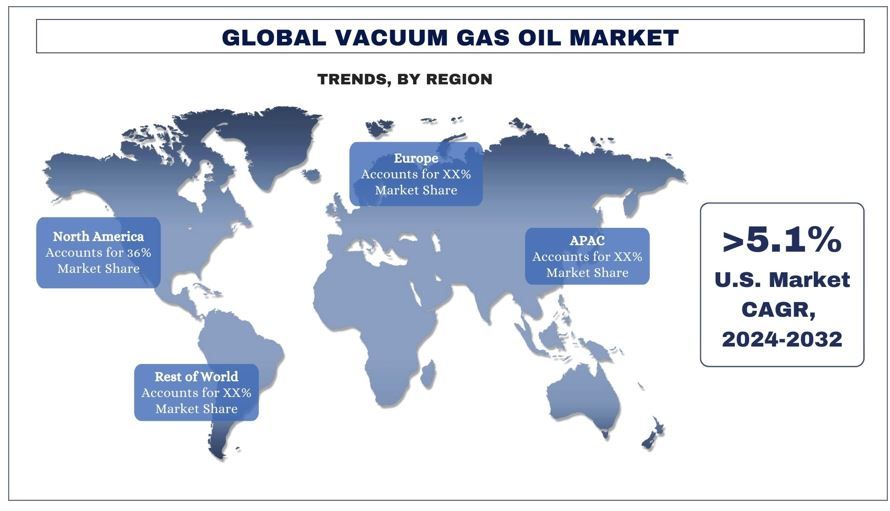
Przegląd branży oleju próżniowego (Vacuum Gas Oil)
Rynek oleju próżniowego jest konkurencyjny, z kilkoma globalnymi i międzynarodowymi graczami rynkowymi. Kluczowi gracze przyjmują różne strategie wzrostu, aby zwiększyć swoją obecność na rynku, takie jak partnerstwa, umowy, współpraca, wprowadzanie na rynek nowych produktów, ekspansje geograficzne oraz fuzje i przejęcia. Niektórzy z głównych graczy działających na rynku to LUKOIL, TAIF-NK, JSC National Company, Par Pacific Holdings, Inc, Neste, Vertex Energy, Honeywell International Inc., Gazprom International Limited, KUWAIT PETROLEUM CORPORATION i China Yuanda Valve Group Co., Ltd
Wiadomości z rynku oleju próżniowego (Vacuum Gas Oil)
W 2020 roku Sinopec ogłosił plany zainwestowania około 6,8 miliarda USD w budowę nowego kompleksu rafineryjno-petrochemicznego w Zhanjiang, w prowincji Guangdong.
W 2021 roku Marathon ogłosił inwestycję w wysokości 1,2 miliarda USD w modernizację swojej rafinerii Garyville w Luizjanie, koncentrując się na zwiększeniu możliwości hydrokrakingu w celu przetwarzania większej ilości VGO na ultra-niskosiarkowy olej napędowy i inne produkty o wysokiej wartości. Ta inwestycja odzwierciedla strategiczne działania północnoamerykańskich rafinerii mające na celu wykorzystanie VGO do produkcji czystszych i wydajniejszych paliw.
Zakres raportu na temat rynku oleju próżniowego (Vacuum Gas Oil)
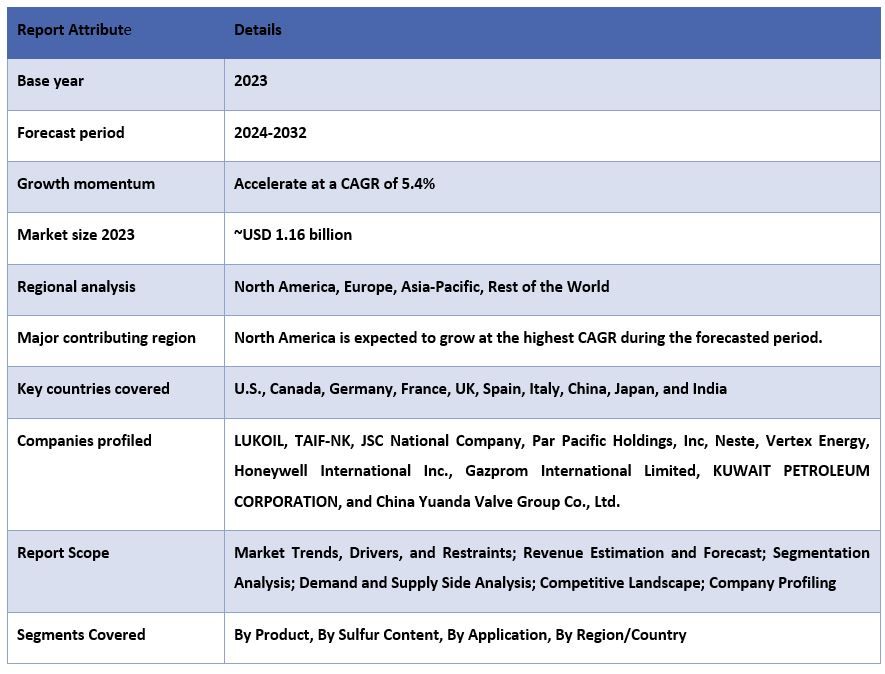
Powody, dla których warto kupić ten raport:
- Badanie obejmuje analizę wielkości rynku i prognoz zweryfikowaną przez autentycznych kluczowych ekspertów branżowych.
- Raport przedstawia szybki przegląd ogólnej wydajności branży na pierwszy rzut oka.
- Raport obejmuje dogłębną analizę wybitnych firm z branży, z głównym naciskiem na kluczowe dane finansowe przedsiębiorstw, portfele produktów, strategie ekspansji i najnowsze wydarzenia.
- Szczegółowe badanie czynników napędzających, ograniczeń, kluczowych trendów i możliwości występujących w branży.
- Badanie kompleksowo obejmuje rynek w różnych segmentach.
- Dogłębna analiza branży na poziomie regionalnym.
Opcje dostosowania:
Globalny rynek oleju próżniowego można dodatkowo dostosować zgodnie z wymaganiami lub dowolnym innym segmentem rynku. Poza tym UMI rozumie, że możesz mieć własne potrzeby biznesowe; dlatego skontaktuj się z nami, aby uzyskać raport, który w pełni odpowiada Twoim wymaganiom.
Spis treści
Metodologia badań dla analizy rynku oleju próżniowego (2022-2032)
Analiza historycznego rynku, szacowanie obecnego rynku i prognozowanie przyszłego rynku globalnego oleju próżniowego to trzy główne kroki podjęte w celu stworzenia i analizy adopcji oleju próżniowego w głównych regionach na całym świecie. Przeprowadzono wyczerpujące wtórne badania, aby zebrać historyczne dane rynkowe i oszacować obecną wielkość rynku. Po drugie, wzięto pod uwagę liczne ustalenia i założenia, aby potwierdzić te spostrzeżenia. Ponadto przeprowadzono również wyczerpujące wywiady pierwotne z ekspertami branżowymi w całym łańcuchu wartości globalnego rynku oleju próżniowego. Po założeniu i zatwierdzeniu danych rynkowych poprzez wywiady pierwotne, zastosowaliśmy podejście odgórne/oddolne do prognozowania całkowitej wielkości rynku. Następnie przyjęto metody podziału rynku i triangulacji danych w celu oszacowania i analizy wielkości rynku segmentów i podsegmentów branży. Szczegółowa metodologia jest wyjaśniona poniżej:
Analiza historycznej wielkości rynku
Krok 1: Dogłębne badanie źródeł wtórnych:
Przeprowadzono szczegółowe badanie wtórne w celu uzyskania historycznej wielkości rynku oleju próżniowego za pośrednictwem wewnętrznych źródeł firmy, takich jak raporty roczne i sprawozdania finansowe, prezentacje wyników, komunikaty prasowe itp., oraz źródeł zewnętrznych, w tym czasopism, wiadomości i artykułów, publikacji rządowych, publikacji konkurencji, raportów sektorowych, baz danych stron trzecich i innych wiarygodnych publikacji.
Krok 2: Segmentacja rynku:
Po uzyskaniu historycznej wielkości rynku oleju próżniowego przeprowadziliśmy szczegółową analizę wtórną, aby zebrać historyczne informacje rynkowe i udział w różnych segmentach i podsegmentach dla głównych regionów. Główne segmenty uwzględnione w raporcie to produkt, zawartość siarki, zastosowanie i regiony. Przeprowadzono dalsze analizy na poziomie krajowym, aby ocenić ogólną adopcję modeli testowania w danym regionie.
Krok 3: Analiza czynnikowa:
Po uzyskaniu historycznej wielkości rynku różnych segmentów i podsegmentów przeprowadziliśmy szczegółową analizę czynnikową, aby oszacować obecną wielkość rynku oleju próżniowego. Ponadto przeprowadziliśmy analizę czynnikową przy użyciu zmiennych zależnych i niezależnych, takich jak produkt, zawartość siarki, zastosowanie i regiony rynku oleju próżniowego. Przeprowadzono dogłębną analizę scenariuszy popytu i podaży, biorąc pod uwagę najważniejsze partnerstwa, fuzje i przejęcia, ekspansję biznesową i premiery produktów w sektorze rynku oleju próżniowego na całym świecie.
Szacowanie obecnej wielkości rynku i prognoza
Określanie obecnej wielkości rynku: Na podstawie praktycznych wniosków z powyższych trzech kroków doszliśmy do obecnej wielkości rynku, kluczowych graczy na globalnym rynku oleju próżniowego i udziałów w rynku poszczególnych segmentów. Wszystkie wymagane udziały procentowe i podziały rynku zostały określone przy użyciu wspomnianego powyżej podejścia wtórnego i zostały zweryfikowane poprzez wywiady pierwotne.
Szacowanie i prognozowanie: Do oszacowania i prognozy rynku przypisano wagi różnym czynnikom, w tym czynnikom napędzającym i trendom, ograniczeniom i możliwościom dostępnym dla interesariuszy. Po przeanalizowaniu tych czynników zastosowano odpowiednie techniki prognozowania, tj. podejście odgórne/oddolne, aby dojść do prognozy rynkowej na 2032 r. dla różnych segmentów i podsegmentów na głównych rynkach na całym świecie. Metodologia badawcza przyjęta do oszacowania wielkości rynku obejmuje:
- Wielkość rynku branży pod względem przychodów (USD) i wskaźnik adopcji rynku oleju próżniowego na głównych rynkach krajowych
- Wszystkie udziały procentowe, podziały i podziały segmentów i podsegmentów rynku
- Kluczowi gracze na globalnym rynku oleju próżniowego pod względem oferowanych produktów. Ponadto strategie rozwoju przyjęte przez tych graczy, aby konkurować na szybko rozwijającym się rynku
Walidacja wielkości i udziału w rynku
Badania pierwotne: Przeprowadzono dogłębne wywiady z kluczowymi liderami opinii (KOL), w tym z kadrą kierowniczą najwyższego szczebla (CXO/VPs, szef sprzedaży, szef marketingu, szef operacyjny, szef regionu, szef kraju itp.) w głównych regionach. Następnie podsumowano wyniki badań pierwotnych i przeprowadzono analizę statystyczną w celu udowodnienia postawionej hipotezy. Dane z badań pierwotnych zostały skonsolidowane z wynikami badań wtórnych, przekształcając w ten sposób informacje w praktyczne spostrzeżenia.
Podział uczestników badań pierwotnych w różnych regionach
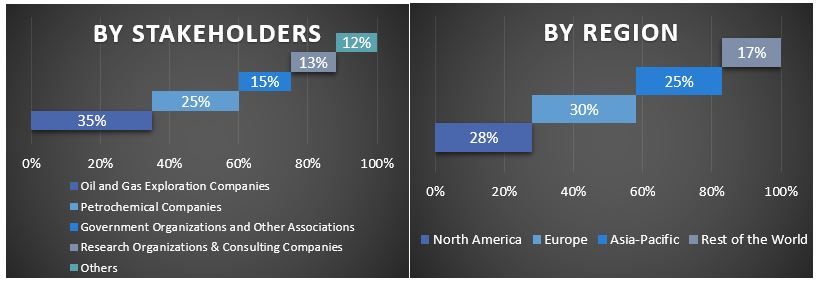
Inżynieria rynku
Zastosowano technikę triangulacji danych, aby zakończyć ogólne szacowanie rynku i uzyskać precyzyjne dane statystyczne dla każdego segmentu i podsegmentu globalnego rynku oleju próżniowego. Dane podzielono na kilka segmentów i podsegmentów po przestudiowaniu różnych parametrów i trendów w zakresie produktu, zawartości siarki, zastosowania i regionów globalnego rynku oleju próżniowego.
Główny cel badania globalnego rynku oleju próżniowego
W badaniu wskazano obecne i przyszłe trendy na globalnym rynku oleju próżniowego. Inwestorzy mogą uzyskać strategiczne informacje, na których mogą oprzeć swoje decyzje dotyczące inwestycji na podstawie analizy jakościowej i ilościowej przeprowadzonej w badaniu. Obecne i przyszłe trendy rynkowe zdeterminowały ogólną atrakcyjność rynku na poziomie regionalnym, zapewniając uczestnikom przemysłowym platformę do wykorzystania niewykorzystanego rynku w celu skorzystania z przewagi pierwszego gracza. Inne cele ilościowe badań obejmują:
- Analiza obecnej i prognozowanej wielkości rynku oleju próżniowego pod względem wartości (USD). Ponadto analiza obecnej i prognozowanej wielkości rynku różnych segmentów i podsegmentów.
- Segmenty w badaniu obejmują obszary produktu, zawartości siarki, zastosowania i regionów.
- Definiowanie i analiza ram regulacyjnych dla oleju próżniowego
- Analiza łańcucha wartości związanego z obecnością różnych pośredników, wraz z analizą zachowań klientów i konkurencji w branży.
- Analiza obecnej i prognozowanej wielkości rynku oleju próżniowego dla głównego regionu.
- Główne kraje regionów badane w raporcie to Azja i Pacyfik, Europa, Ameryka Północna i Reszta Świata
- Profile firm z rynku oleju próżniowego i strategie rozwoju przyjęte przez uczestników rynku, aby utrzymać się na szybko rozwijającym się rynku.
- Dogłębna analiza branży na poziomie regionalnym
Najczęściej zadawane pytania FAQ
P1: Jaka jest obecna wielkość globalnego rynku oleju gazowego próżniowego i jego potencjał wzrostu?
P2: Jakie czynniki napędzają wzrost globalnego rynku oleju próżniowego (VGO)?
Pytanie 3: Który segment ma największy udział w globalnym rynku próżniowych olejów gazowych pod względem produktu?
P4: Jakie są wschodzące technologie i trendy na globalnym rynku oleju próżniowego?
P5: Który region zdominuje globalny rynek oleju gazowego próżniowego?
Powiązane Raporty
Klienci, którzy kupili ten przedmiot, kupili również






